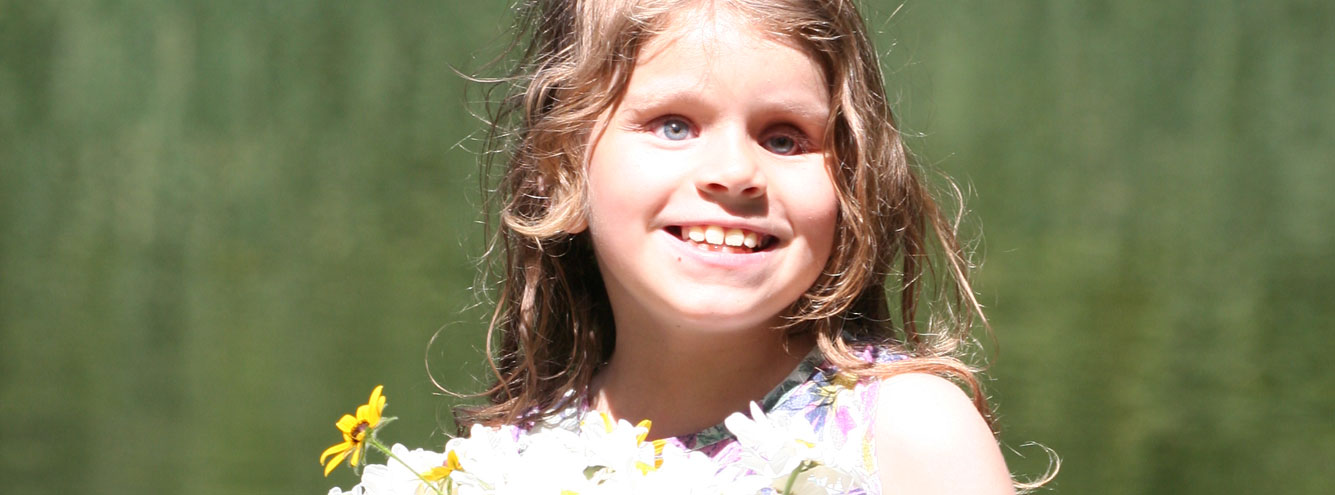On This Page
Seeds of Hope
On September 29, 2004, Abby White, a retinoblastoma survivor and friend of Daisy’s family, received an email from a mother in Africa whose two-year-old daughter had the same cancer. By coincidence, September 29th is also the Feast of St Michael, Patron Saint of Sick Children, often celebrated with wreathes of Michaelmas Daisies.
Gorata (Rati) was diagnosed with a recurrence of retinoblastoma following removal of her eye 19 months before. Such a recurrence is rare in developed countries, but very common in developing countries due to late diagnosis, poor access to expert care and lack of compassionate family support.
Abby began advocating for Rati and her family. Daisy’s parents donated money from The Daisy Fund to enable international travel and initial treatment. Four weeks after Abby received the first email, Rati began intensive therapy at SickKids in Canada.
We established Daisy’s Eye Cancer Fund, in England and at SickKids Foundation, to raise funds for Rati’s care. The UK fund achieved official charity registration in September 2005. We rebranded in 2015 to become World Eye Cancer Hope.
Rati responded very well to therapy for a year, but the gift of expert care came to late for her and the cancer returned. She died on 21 August, 2006. Multiple opportunities to save her life in Africa were missed, and she challenged us to improve care for children like her who suffer so greatly.
Beyond One Child, Sharing Hope for Africa
In September 2006, we launched “Rati’s Challenge”, and a partnership with Kenya’s retinoblastoma community. Abby’s father was diagnosed with Rb in Nairobi in 1946 at 9 months old. The Kenyan National Retinoblastoma Strategy was formed in September 2008. The multidisciplinary team was ground-breaking in East Africa for including parents and survivors.
Over five years, the group developed evidence based care guidelines tailored specifically to Kenya. The Kenyan Guidelines for Retinoblastoma Care were adopted by the Ministry of Health in 2015, and incorporated into the National Cancer Strategy.
In 2009, we brought the first Retcam to Africa, with ORBIS and Clarity Medical Systems. Capturing high-resolution images of the eye was revolutionary for collaborative care, telemedicine, and supporting parents’ decision-making.
We also equipped the Retinoblastoma Collaborative Laboratory, a new pathology service in Nairobi, and facilitated national ocular pathology training. The KNRbS improved communication between ophthalmologists and pathologists, and all these innovations quickly reduced turnaround time for critical post-enucleation care decisions, from more than six months to less than two weeks.
With KNRbS backing, our child life specialist, Morgan Livingstone, launched Africa’s first child life training program in 2008. Kenya now leads the world in training professionals to deliver child and family-centred healthcare supports in low resource settings. Child life specialists trained through Kenya’s program are raising quality of life for children with cancer and their families in Ghana, South Africa, and Malawi.
Greater awareness and advances in imaging, pathology, treatment, child life, and much more empower Kenya to diagnose Rb earlier and offer personalized care, significantly improving outcomes. In 2008, only 26% of children survived. Today, 70% are cured. The national strategy has become an encouraging model for other countries working hard to save lives with limited resources.
From our blog: Transforming Paediatric Care: Child life in Low- and Middle-income Countries
Retinoblastoma Support in America
In 2005, Abby began receiving frequent requests for help from parents and survivors around the world, particularly from the USA. We established the US Chapter of Daisy’s Eye Cancer Fund in response.
Since September 2012, we have provided education, advocacy, practical advice, and emotional support to families and survivors across America. Our US chapter has also become a leader in the global effort to advance retinoblastoma care and cure.
From our blog: Retinoblastoma Family Days: Building Connection, Camaraderie, and Hope
From our blog: Pearls of Light: The Pathway to Retinoblastoma Early Detection
One Retinoblastoma World
Abby noticed that medical conferences addressing Rb lacked focus on psychosocial and lifelong aspects of the cancer. Recognising the need for a unique collaborative space, Daisy’s Eye Cancer Fund UK hosted the first One Rb World meeting in October 2012, just before the World Congress of the International Society of Paediatric Oncology in England.
One Rb World unites families, survivors, clinicians, and researchers on equal footing to share diverse perspectives, and explore key concerns and potential solutions together. Since 2017, diagnosed children, siblings, and children of adult survivors also receive tailored support and skills through the professionally-led Child Life Program, helping them thrive through their cancer experiences.
60 participants from 26 countries met in London. The conference has grown steadily, meeting in Toronto, Dublin, Washington D.C., and two virtual meetings during the pandemic. Most recently, WE C Hope USA hosted 175 participants in Hawaii in October 2024, with many more joining virtually from around the world.
Our hybrid format began in 2017, when travel from certain Islamic countries was denied. This now forms a key part of global access, equity, community, and collaboration at One Rb World.
WE C Hope for All!
In September 2015, Daisy’s Eye Cancer Fund rebranded to World Eye Cancer Hope (WE C Hope), reflecting our evolution from one child to a global mission. WE see for Childhood eye Cancer the Healing Opportunity in Partnership and Empowerment.
Today, WE C Hope works with organizations and people across individual countries and worldwide who share our goal of early diagnosis and optimal holistic care for all children, survivors, and families. Our strength lies in our unique global collaboration of health care professionals, parents and survivors, scientists and others concerned about retinoblastoma. All our activities are motivated by a desire to promote each person’s complete wellbeing.
Though Daisy and Rati never met, the twining of their lives has created a bright legacy of hope for all who are affected by retinoblastoma, and all who care for them, around the world, and throughout life.


